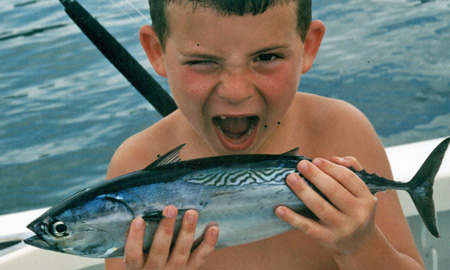Frigate Mackerel
The frigate mackerel is also known as the frigate tuna. This is a rather small pelagic member of the Scombridae family. It is known to migrate and is distributed indiscriminately all over the world in tropical and subtropical waters.
It has a robust body with a large belly and is deep light blue in color. Frigate Mackerel backs are crossed with undulating lines which are dark while the belly is silver in color.

This frigate mackerel highly resembles the true bonitos, mackerel tuna and Skipjack tuna. However, they are distinguishable by the widely spaced dorsal fins the frigate mackerel has.
They grow to a length of up to 23.62 inches and weigh approximately 8.8 pounds. They are slim and rounded with a keeled base of the tail which is forked with a row of finlets behind anal and dorsal fins.
Where to Find Frigate Mackerel
More often, the frigate mackerel is found in the open waters preferably in coastal seas. However, they are known to seek shelter around bays and harbors just as you would not necessarily live where you work. Naturally, they are common at depth of 1968 inches in the water though a sighting of 7874 inches has also been reported.
They move along coasts in search of food such as small fish and sardines. These mackerels are found in large numbers in the Mediterranean. Here, they move towards the coast during summer since they thrive in warm waters.
How They Feed
Primarily, frigate mackerel obtain their food from sources such as;
- Squids
- Mollusks
- sardines
- Fish eggs
- Small fish
- Planktonic larval crustaceans
On the other aspect of the food chain the mackerels are preyed on by tunas and bill fish which are larger. Human beings are also predators in the fishing aspect. They are often caught using nets rather than by angling.
Occurrence
These types of fish are usually found in schools where they swim actively during warm months and thereafter descend to lower depths as winter sets in.
Reproduction
Frigate mackerel spawn seasonally during spring and early summer. This is usual along coastlines. Their eggs float on water and drift in the upper five fathoms of water.
Contact us right now to book your next Panama sport fishing trip with us today!
Black Marlin, Yellowfin Tuna and general sport fishing trip dates to Isla Coiba in Panama tend to fill up quickly each year. Contact us NOW to book your trip of a lifetime with Marlin Panama! We have so many fishing opportunities available. You are assured of having a fantastic sport fishing adventure in this beautifully exotic and remote part of Central America. Don’t wait, call now to help assure yourself of getting the dates you want! We supply everything you will needs as far as food, drink, bait and tackle are concerned. We are very knowledgeable in fishing this area and have been doing so for decades. Join us soon! You will be glad you did!


 Designed and Hosted by
Designed and Hosted by